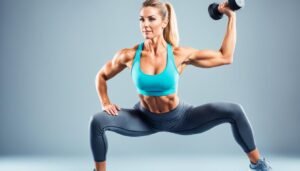Get our FREE E-Book HERE - 120 TIPS for Losing Weight & Bonus Tips for Postpartum Weight Loss & Dad’s Postpartum Experience
How to Weigh Yourself Without a Scale: 11 Ways
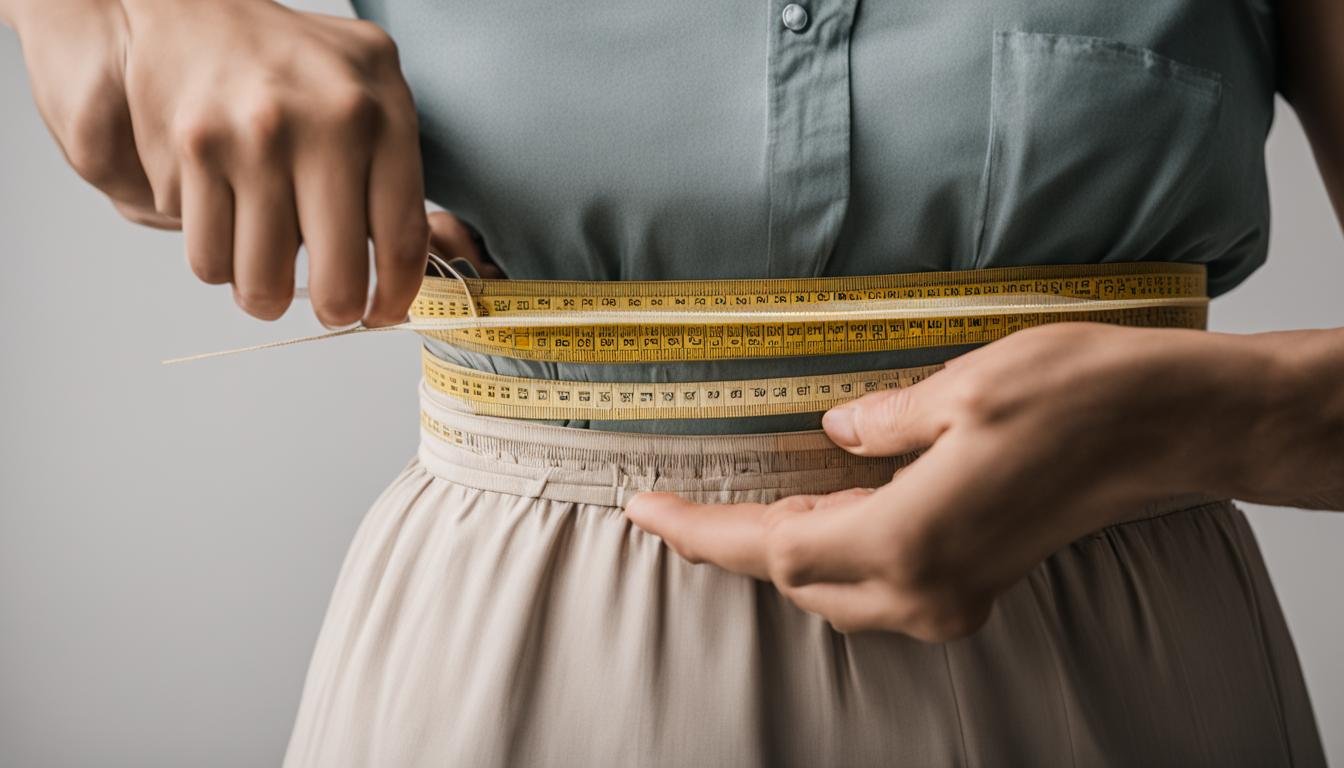
Have you ever found yourself standing in front of a traditional scale, dreading the moment when the numbers flash before your eyes? It’s a common scenario for many of us who are on a weight loss or fitness journey. But what if I told you that there are ways how to weigh yourself without a scale?
Let me share a funny story with you. Meet Sarah, a fitness enthusiast who was determined to track her weight loss journey. She followed a strict diet and exercise routine, but she couldn’t bear the thought of stepping on a scale. Instead, she decided to take a different approach.
Sarah turned to the mirror as her trusted measuring tool. She noticed a subtle difference in her body shape and the way her clothes fit. Her favorite pair of jeans, which used to be snug, now had a little extra room around the waist. It was a small victory, but it motivated her to keep pushing forward.
With a newfound confidence, Sarah decided to explore other non-scale methods to measure her progress. She experimented with skinfold calipers to measure her body fat percentage, used tape measures to track her waist circumference and even took before and after photos to visually document her transformation. Each method provided a unique perspective on her weight loss journey and gave her a more well-rounded understanding of her progress.
But what about you? If you’re tired of relying solely on a scale, you’re in the right place. In this article, we’ll explore alternative methods for weighing yourself without a scale, allowing you to gain valuable insights into your body composition. We’ll discuss practical tips for weighing yourself at home and delve into different techniques such as skinfold calipers, tape measures, before and after photos, and more.
So, are you ready to step off the scale and discover new ways to measure your progress? Let’s dive in and unlock the secrets of non-scale weight measurement!
The Importance of Knowing Your Body Composition
Understanding your body composition is crucial for assessing overall health and fitness progress. It involves differentiating between fat and muscle mass in your body. Traditional scales cannot provide this information, as they only measure total body mass. By knowing your body composition, you can get a more accurate understanding of weight loss or gain. Additionally, measuring body composition without a scale allows you to track changes in fat and muscle, helping you make informed decisions about your fitness routine and diet.
Differentiating Between Fat and Muscle
Differentiating between fat and muscle is important because they have different effects on your health and body shape. While fat can contribute to weight gain and increase the risk of health issues, such as heart disease and diabetes, muscle is metabolically active and can help improve overall strength and metabolism. By regularly monitoring your body composition, you can determine whether you are losing fat, gaining muscle, or both, which is a more meaningful measure of progress than just relying on total body weight.
The Shortcomings of Standard Scales
Standard scales have limitations when it comes to providing comprehensive weight measurement. They only measure your total body mass and do not account for variations in body composition. This can be misleading, as it is possible to have a higher weight due to increased muscle mass while simultaneously reducing body fat. By relying solely on a scale, you might miss out on important progress and improvements in your body composition. Therefore, measuring weight without a scale becomes important in order to get a more accurate picture of your overall health and fitness journey.
How to Weigh Yourself Without a Scale at Home: Practical Tips
Weighing yourself at home without a scale may seem like a daunting task, but fear not! We’ve got some practical tips to help you out. Who needs a scale anyway? Let’s get creative with our weight measurement techniques!
Step 1: Skinfold Calipers
Have you ever heard of skinfold calipers? These handy little tools can give you a good estimate of your body fat percentage. Simply pinch your skin and measure the thickness of the fold with the calipers. It’s like playing a game of pinch and measure!
Step 2: Before and After Photos
They say a picture is worth a thousand words, and that’s especially true when it comes to tracking your weight. Take a before photo and an after photo, and compare the two. You’ll be amazed at the visual changes in your body composition!

Step 3: Clothing Fit
Your clothes can be a great indicator of weight change. Pay attention to how your favorite pair of jeans fits. If they start to feel a little looser or tighter, it could be a sign of progress!
Step 4: Tape Measures
A trusty tape measure can come in handy for measuring body circumference. Start by accurately measuring your waist, and keep track of the numbers over time. It’s an easy and convenient way to monitor your weight without a scale.
By following these practical tips, you can measure your weight at home without relying on a traditional scale. Who said you need fancy equipment to track your progress? Get creative, have fun with it, and remember that there’s more to health than just a number on a scale!
1. Understanding Skinfold Calipers
Another way on how to weigh yourself without a scale is by using Skinfold Calipers. Skincare enthusiasts may have heard of skinfold calipers, but did you know they can also be used for body composition analysis? These handy tools are a clever alternative to weighing yourself on a scale. By measuring the thickness of skinfold sites on your body, you can estimate your body fat percentage. Let’s delve into how skinfold calipers work and explore the advantages and disadvantages of using them for weight measurement.
How Skinfold Calipers Work
Skinfold calipers work by gently pinching and measuring the folds of skin at specific sites on your body. These sites usually include areas like the triceps, biceps, chest, and thighs. By measuring the thickness of these skinfold sites, you can estimate the amount of subcutaneous fat beneath the skin. The measurements are then used in formulas to calculate your body fat percentage and assess your overall body composition.
Advantages and Disadvantages of Using Calipers
Using skinfold calipers for body composition analysis offers several advantages. Firstly, it provides a more accurate measurement of body fat percentage compared to traditional scales. Additionally, skinfold calipers are affordable and accessible, making them a popular choice for fitness enthusiasts and professionals alike.
However, it’s important to note that using skinfold calipers requires some skill and practice to ensure accurate measurements. The results may also vary depending on the proficiency of the person using the calipers and the specific formula used for calculation. It’s crucial to use standardized procedures and consult a professional if you’re unsure about the measurements.
While skinfold calipers are an effective method for estimating body fat percentage, they don’t provide a comprehensive analysis of overall body composition. Other methods, such as dual-energy X-ray absorptiometry (DEXA) or air displacement plethysmography (ADP), may be more suitable if you require a more detailed assessment of your body composition.
2. Tracking Progress with Before and After Photos
When it comes how to weigh yourself without a scale, before and after photos can be a powerful tool. These visual snapshots allow you to witness the transformation of your body composition over time. By capturing photos before embarking on your weight loss journey and comparing them to current photos, you can see the remarkable changes that have occurred.
To incorporate before and after photos into your weight loss tracking, follow these tips for consistent and accurate images:
- Lighting: Find a well-lit area that highlights your features clearly. Natural light is ideal, but if that’s not possible, use bright indoor lighting.
- Posing: Take pictures from the same angles each time, focusing on areas of concern or where you have seen noticeable changes.
- Clothing: Wear form-fitting attire that showcases your body’s contours. This ensures that any changes in your physique are visible.
- Background: Use a plain and uncluttered background to keep the focus on your body. A blank wall or an open space works well.
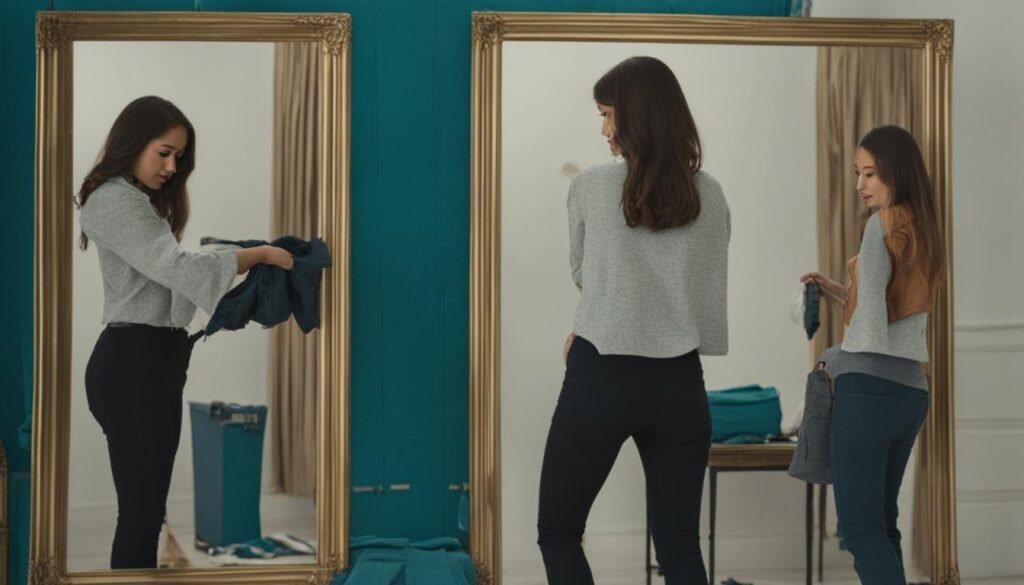
By capturing consistent and accurate before and after photos, you can visually track your weight loss progress and celebrate your achievements along the journey
3. How Clothing Fit Can Indicate Weight Change
Changes in clothing fit can be an indicator of weight change, even without using a scale. It’s like having your personal weight measurement system right in your closet! By paying attention to how your clothes fit, you can gauge whether you have lost or gained weight. And the best part? No fancy gadgets or measurements are required.
The Role of Clothing in Monitoring Body Size Variations
Clothing serves as a tangible reflection of your body size and shape. When your clothes start to feel looser or tighter, it’s a sign that something is changing. Whether it’s shedding a few pounds or gaining muscle mass, your clothing can tell you a lot about your body’s transformation. It’s like your own stylish weight tracker!
So, grab that pair of jeans you’ve been eyeing and use it as your personal measuring tool. If it’s becoming easier to slide into them or if they’re hugging you just right, take it as a victory lap! On the other hand, if your clothes feel a bit snugger, it may be time to reevaluate your lifestyle and make adjustments.
Practical Tips for Using Clothing as a Weight Measurement Method
Here are some practical tips to help you use clothing as a weight measurement technique effectively:
- Pick a specific item of clothing, like your favorite pair of jeans or a form-fitting dress. This will serve as your benchmark.
- Regularly try on that item of clothing to see if it fits differently. Pay attention to how it feels on your body.
- Take note of any changes in how the clothing fits. Is it looser or tighter than before? This will provide insights into your weight changes.
- Don’t rely on just one piece of clothing. Try multiple items to get a more comprehensive view of your body’s transformation.
- Remember that clothing fit can be influenced by factors other than weight, such as bloating or muscle gain. Take these factors into account when interpreting the results.
4. Utilizing Tape Measures for Body Circumference
Are you still wondering how to weigh yourself without a scale? Yes, measuring your weight without a scale can be a challenge, but fear not! There are alternative methods that can give you an accurate idea of your body weight. One such method is using tape measures to measure your body circumference. By tracking changes in your waist measurements, you can monitor your progress over time.
Now you might be wondering, how do I accurately measure my waist using a tape measure? It’s simple! Just follow these step-by-step instructions:
Steps to Accurately Measure Your Waist
- Stand straight with your feet shoulder-width apart.
- Wrap the tape measure around your waist, just above your belly button.
- Ensure the tape measure is parallel to the ground and snug against your skin, but not too tight.
- Take a deep breath and exhale gently. Avoid sucking in your stomach or pushing it out.
- Read the measurement on the tape measure without bending or twisting.
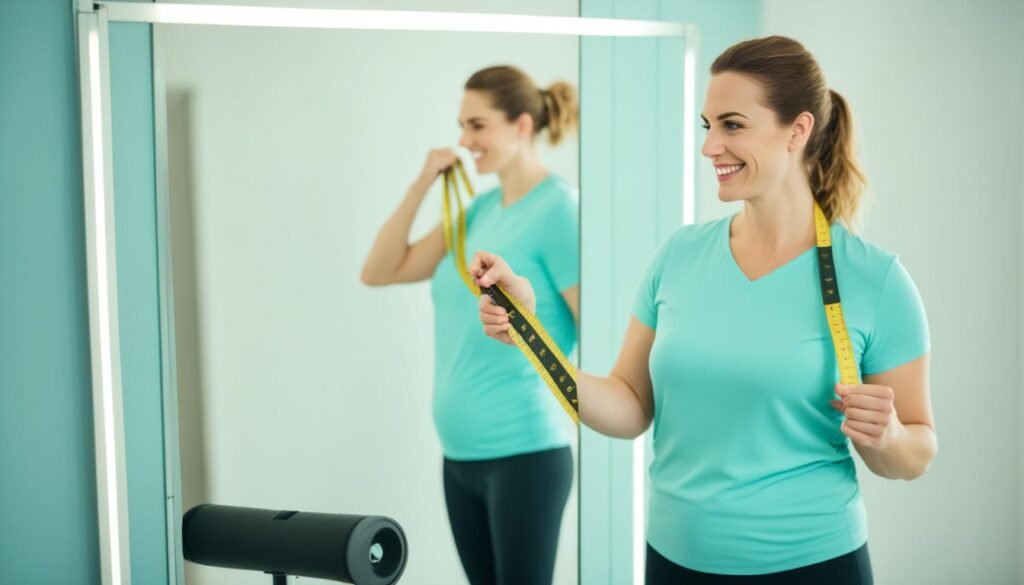
By following these steps, you can accurately measure your waist circumference, allowing you to track changes in your body weight. But what do the numbers obtained from tape measurements mean? Let’s find out!
Interpreting the Numbers from Tape Measurements
The numbers you obtain from tape measurements are a reflection of your body composition. As you lose weight or gain muscle, your waist measurement may decrease or increase accordingly. Remember, weight is just a number, and focusing on body composition can provide a more holistic view of your progress.
Keep in mind that tape measurements should be used as one of several methods to track your weight. Combining them with other non-scale techniques, such as skinfold calipers or before and after photos, can help paint a clearer picture of your body changes.
5. Advanced Methods: Hydrostatic Weighing Explained
You’ve explored various non-scale methods of how to weigh yourself without a scale and track your weight loss or gain. However, if you’re seeking a more advanced approach to determining your body composition, hydrostatic weighing is the way to go. This method provides accurate weight measurement and valuable insights into your overall health and fitness.
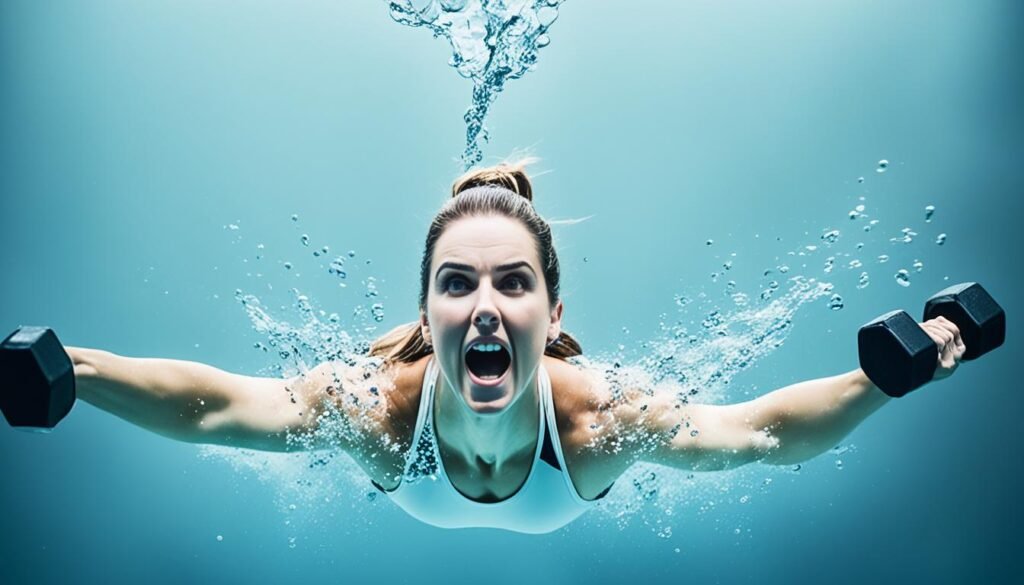
Hydrostatic weighing works by measuring your body density. It is typically performed in a specialized tank filled with water. During the procedure, your weight is measured outside the water, and then again while submerged in water. By comparing these measurements, the density of your body can be calculated, allowing for an estimation of body fat percentage.
Although hydrostatic weighing is considered a gold standard in body composition analysis, it is not suitable for at-home use due to its technical requirements. The equipment and expertise needed to perform the test are typically found in specialized facilities or research settings.
However, understanding the principles behind hydrostatic weighing can enhance your knowledge about weight measurement and the factors that contribute to your body composition. It highlights the significance of accurate weight measurement and provides a benchmark for other non-scale methods discussed in this article.
While hydrostatic weighing may not be practical for everyone, it serves as a reminder that there are advanced methods available for those seeking precise and in-depth body composition analysis.
6. What is DEXA and How Does it Measure Body Composition?
Dual-energy X-ray absorptiometry (DEXA) is a medical imaging technique used for measuring body composition. Unlike traditional scales, DEXA scans offer a comprehensive assessment of your body’s fat, muscle mass, and bone density. So, how does DEXA work?
The Science Behind DEXA Scans
During a DEXA scan, two low-dose X-ray beams pass through your body to measure the amount of X-ray energy that is absorbed by different tissues. This information helps identify the composition of your body, including fat, muscle, and bone. This is one of the most accurate ways on how to weigh yourself without a scale.
Pros and Cons of DEXA for Body Composition Analysis
DEXA scans provide accurate and detailed information about your body composition, making them an excellent alternative to traditional scales. Here are some pros and cons to consider:
- Pros: DEXA scans are highly accurate, producing precise measurements and insights into your body fat percentage, muscle mass, and bone density. They can help you track changes over time and provide valuable data for tailored fitness and nutrition plans.
- Cons: DEXA scans can be expensive and are typically performed in medical or research settings, making them less accessible for regular weight monitoring. Additionally, the radiation exposure is minimal but still present, so the procedure may not be suitable for individuals who are pregnant or have certain medical conditions.
While DEXA scans offer a comprehensive way to assess body composition, it’s important to consider the cost and access to these scans before choosing this method for measuring your weight without a scale.
7. Understanding Air Displacement Plethysmography (ADP)
Air displacement plethysmography (ADP) is a fascinating method used to measure body composition. Forget about weighing scales, with ADP, you can get a comprehensive understanding of your body fat percentage and lean mass without stepping on a scale.
So, how does ADP work? Well, it’s all about air. ADP measures body volume by calculating the amount of air displaced when you enter a specially designed chamber, also known as the Bod Pod. As you sit comfortably inside, the air pressure changes, and the machine determines your body composition based on the volume of air displaced.

ADP is a non-invasive alternative to traditional scales, providing accurate measurements without the hassle of stepping onto a weighing scale. By using ADP, you can track changes in your body composition over time, making it an excellent tool for those focused on body fat percentage and lean mass.
8. The Role of Bioelectrical Impedance Analysis (BIA)
When it comes to measuring your weight without a scale, bioelectrical impedance analysis (BIA) is a method that can provide valuable insights into your body composition. Using electrical signals, BIA estimates your body fat percentage and helps you understand the distribution of lean mass and fat in your body.
With BIA, you can go beyond just knowing your total body weight and gain a deeper understanding of your overall health and fitness. By analyzing how electrical current flows through your body, BIA can calculate weight without a weighing scale, providing a convenient and informative alternative method.
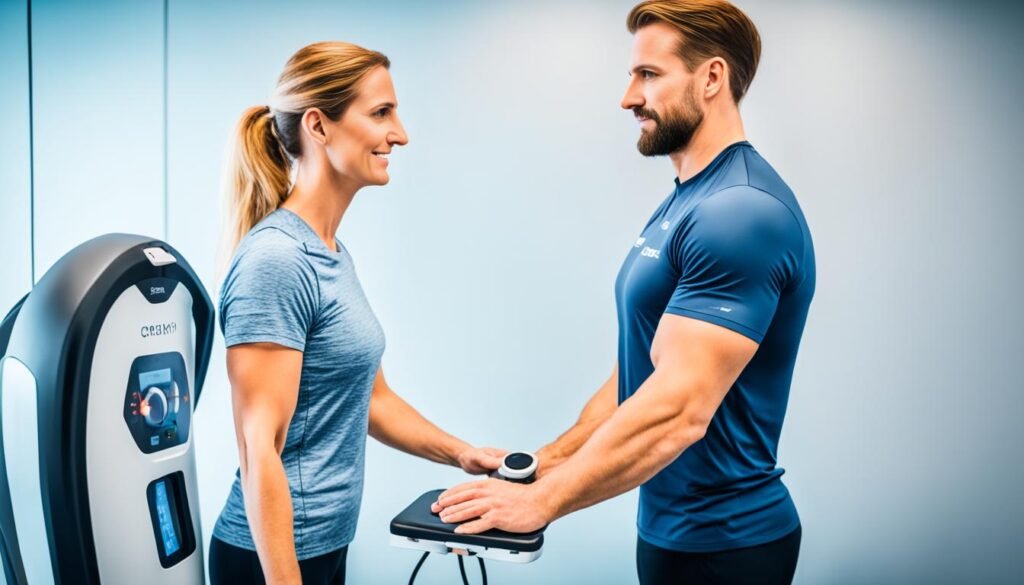
Using BIA is fairly simple. The method typically involves standing on a BIA machine or holding handheld devices that send a safe electrical signal through your body. The resistance encountered by this signal helps measure your body composition, including fat mass and fat-free mass.
It’s important to note that while BIA is a popular method, it does have its limitations. Factors like hydration levels, body temperature, and the presence of any medical implants can affect the accuracy of BIA measurements. Nonetheless, BIA can still provide valuable insights, especially when used consistently over time to track changes in your body composition.
So, if you’re curious about understanding more than just your total body weight, consider incorporating BIA into your non-scale weight measurement methods. It’s a convenient and informative way to gain insights into your body composition and work towards your health and fitness goals.
9. Magnetic Resonance Imaging (MRI) for In-depth Body Composition Analysis
Magnetic resonance imaging (MRI) is a powerful diagnostic tool used in medical imaging. It offers a comprehensive and in-depth analysis of the body’s composition, making it valuable in weight measurement.
With MRI techniques, you can gain a deeper understanding of your body composition, including fat distribution, muscle mass, and even bone density. Unlike traditional scales, MRI provides a detailed view of your overall health and fitness.
Although MRI may not be readily accessible for general weight monitoring, understanding its capabilities can provide insights into the complexities of body composition. When it comes to determining weight without a scale or measuring weight without scale, MRI can be a game-changer.
To visualize the amazing capabilities of MRI, take a look at the image below:
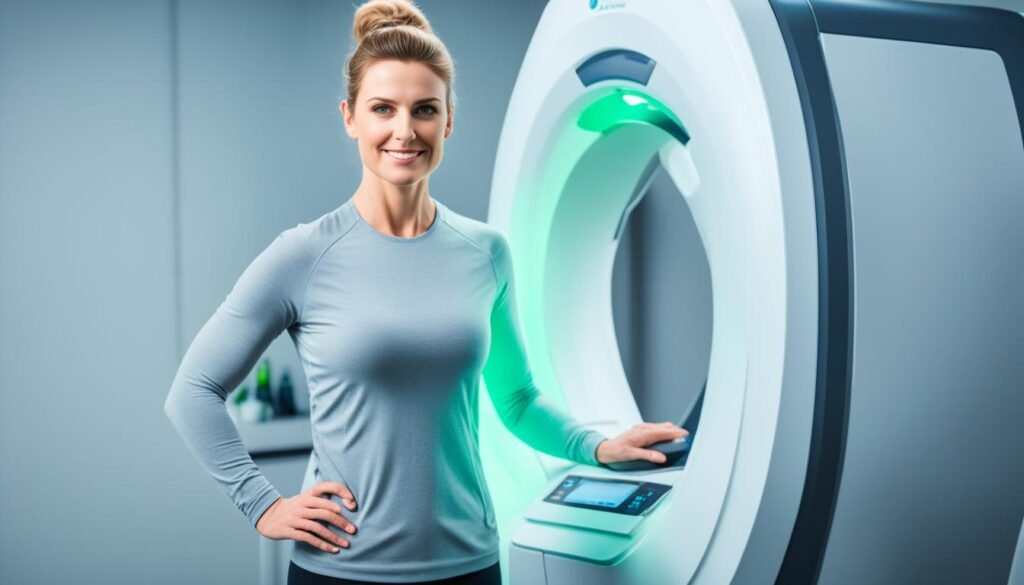
Caption: Magnetic Resonance Imaging (MRI) for in-depth body composition analysis.
10. Using Ultrasound to Measure Body Composition
Ultrasound is not just for monitoring your baby’s development during pregnancy. It’s also a powerful tool for measuring body composition. By using ultrasound, you can get a closer look at what’s going on beneath the surface, allowing for a more accurate assessment of your weight and body fat percentage.

Pros and Cons of Ultrasound in Body Fat Estimation
Like any method, ultrasound has its pros and cons when it comes to estimating body fat. On the positive side, ultrasound is a non-invasive and painless procedure. It uses high-frequency sound waves to create images of the internal structures of your body, allowing for a detailed analysis of your body composition.
One of the main advantages of ultrasound is its ability to distinguish between different types of tissue, such as fat and muscle. This means you can get a more accurate measurement of your body fat percentage, which can be useful for tracking your progress during weight loss or muscle gain.
On the downside, ultrasound measurements can be affected by factors such as body position, hydration level, and the skill of the technician performing the procedure. Additionally, ultrasound devices can be expensive and not readily available for everyday use.
Despite these limitations, ultrasound remains a valuable tool for body composition analysis. It can provide insights into your weight and body fat distribution, helping you make informed decisions about your health and fitness goals.
11. The See Saw Method: A Creative Approach to Estimating Weight
Who says weighing yourself can’t be fun and interactive? Introducing the See Saw Method, a creative way to estimate your weight without using a scale. While it may not provide precise measurements, this method allows you to gauge weight changes uniquely and engagingly.
The See Saw Method works by using a simple principle of physics. Just like a see-saw, you can create a balance using known weights and compare how it feels with your own body weight. By carefully adjusting the weights on one side of the see-saw until it is perfectly balanced, you can estimate your weight based on the known weights and the position of the fulcrum.

However, it’s important to note that the See Saw Method has its limitations. It may not provide the same level of accuracy as other weight measurement techniques, such as using a scale or specialized equipment. The See Saw Method is more of a fun and creative way to estimate weight rather than a scientifically precise measurement.
So, the next time you’re looking to measure your weight without a scale, why not give the See Saw Method a try? It can add a touch of excitement to your weight monitoring journey and make the process more enjoyable.
Conclusion
In conclusion, you now have a variety of ways to measure your weight without relying on a traditional scale. These non-scale weight measurement techniques provide more accurate insights into your weight loss or gain journey. Whether you choose to use skinfold calipers, before and after photos, tape measures, or other methods, each offers a unique perspective on your body composition.
However, it’s important to remember that weight is just one aspect of your overall health and fitness. Taking a holistic approach means considering factors beyond mere body weight. The number on the scale does not define your worth or your progress. It’s essential to focus on how you feel, your energy levels, and your overall well-being.
By incorporating these non-scale weight measurement techniques and embracing a holistic view, you can develop a more comprehensive understanding of your body and your overall health. Remember, it’s not just about the numbers. It’s about feeling strong, healthy, and confident in your own skin.




